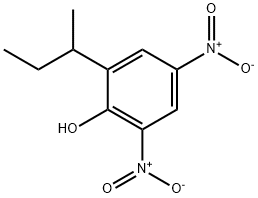4,6-Dinitro-2-sec-butylphenol

|
- ₹3085.6 - ₹4156.8
- Product name: 4,6-Dinitro-2-sec-butylphenol
- CAS: 88-85-7
- MF: C10H12N2O5
- MW: 240.21
- EINECS:201-861-7
- MDL Number:MFCD00024246
- Synonyms:DINOSEB 100MG NEAT;unicropdnbp ;Vertac dinitro weed killer;Vertac general weed killer;Vertac selective weed killer;vertacdinitroweedkiller ;vertacgeneralweedkiller ;vertacselectiveweedkiller
2 prices
Selected condition:
Brand
- Sigma-Aldrich(India)
Package
- 100MG
- 1ML
- ManufacturerSigma-Aldrich(India)
- Product number48378
- Product descriptionDinoseb solution 200?μg/mL in methylene chloride, PESTANAL?, analytical standard
- Packaging1ML
- Price₹3085.6
- Updated2022-06-14
- Buy
- ManufacturerSigma-Aldrich(India)
- Product number45453
- Product descriptionDinoseb PESTANAL?, analytical standard
- Packaging100MG
- Price₹4156.8
- Updated2022-06-14
- Buy
| Manufacturer | Product number | Product description | Packaging | Price | Updated | Buy |
|---|---|---|---|---|---|---|
| Sigma-Aldrich(India) | 48378 | Dinoseb solution 200?μg/mL in methylene chloride, PESTANAL?, analytical standard | 1ML | ₹3085.6 | 2022-06-14 | Buy |
| Sigma-Aldrich(India) | 45453 | Dinoseb PESTANAL?, analytical standard | 100MG | ₹4156.8 | 2022-06-14 | Buy |
Properties
Melting point :55.5°C
Boiling point :382.92°C (rough estimate)
Density :1.29
vapor pressure :0.01Pa at 25℃
refractive index :1.6620 (estimate)
Flash point :>100 °C
storage temp. :2-8°C
solubility :Chloroform (Slightly), Methanol (Slightly)
pka :4.62(at 25℃)
Specific Gravity :1
Water Solubility :0.0052 g/100 mL
Merck :13,3317
Stability :Stable. Strong oxidizing agent. Incompatible with reducing agents, combustible material.
LogP :1.26 at 22℃
CAS DataBase Reference :88-85-7(CAS DataBase Reference)
NIST Chemistry Reference :2-Sec-butyl-4,6-dinitrophenol(88-85-7)
EPA Substance Registry System :Dinoseb (88-85-7)
Boiling point :382.92°C (rough estimate)
Density :1.29
vapor pressure :0.01Pa at 25℃
refractive index :1.6620 (estimate)
Flash point :>100 °C
storage temp. :2-8°C
solubility :Chloroform (Slightly), Methanol (Slightly)
pka :4.62(at 25℃)
Specific Gravity :1
Water Solubility :0.0052 g/100 mL
Merck :13,3317
Stability :Stable. Strong oxidizing agent. Incompatible with reducing agents, combustible material.
LogP :1.26 at 22℃
CAS DataBase Reference :88-85-7(CAS DataBase Reference)
NIST Chemistry Reference :2-Sec-butyl-4,6-dinitrophenol(88-85-7)
EPA Substance Registry System :Dinoseb (88-85-7)
Safety Information
| Symbol(GHS): |
   
|
||||||||||||||||||||||||||||||||||||||||||||||||||||||||
|---|---|---|---|---|---|---|---|---|---|---|---|---|---|---|---|---|---|---|---|---|---|---|---|---|---|---|---|---|---|---|---|---|---|---|---|---|---|---|---|---|---|---|---|---|---|---|---|---|---|---|---|---|---|---|---|---|---|
| Signal word: | Danger | ||||||||||||||||||||||||||||||||||||||||||||||||||||||||
| Hazard statements: |
|
||||||||||||||||||||||||||||||||||||||||||||||||||||||||
| Precautionary statements: |
|
Description
Dinoseb, also known as dinitrophenol, can adversely affect the energy generating reaction in a cell. No cell will live very long under the influence of high concentrations of dinitrophenol. It makes the body burn enough energy to result in weight loss. During the 1930s, physicians unwittingly prescribed certain types of dinitrophenol as diet pills.Dow Chemical changed the basic structure of dinitrophenol slightly to produce dinoseb, which was marketed in 1948. Dinoseb was widely used as a contact herbicide against broadleaf weeds.
Dinoseb causes toxicity the same way in plants, animals, and fungi because all cells contain very similar biochemical pathways for creating energy from the breakdown of sugars. Furthermore, photosynthesis in plants relies on an energy transfer system that is also inhibited by dinitrophenol.
Given the high toxicity, EPA concluded that the doses causing the birth defects and the endocrine-disrupting effects were close to worker exposure levels. Thus, under an emergency order issued in 1986, EPA suspended dinoseb’s registration. In August 1990, the EPA banned the burying of dinoseb-contaminated soils in EPA-approved landfills, making incineration the only EPA-approved disposal method for dinoseb-contaminated soil. Incineration is expensive and incomplete, leaving a noncombustible residue as a further hazardous waste and some combustion products that could remain toxic. Therefore, an ex situ soil bioremediation process was developed by the Sabre Processing company. This process is known as the SABRE process; it uses an anaerobic consortium and supplemental carbon source at the field scale to successfully remediate contaminated soils.
Related product price
- Propyl butyrate
₹1900-121456.5 - Methyl acrylate
₹693-29790.4 - Propyl gallate
₹999-104645.28






